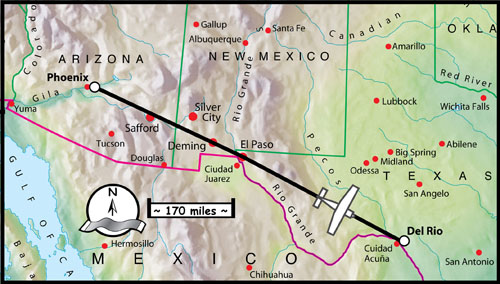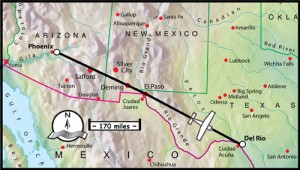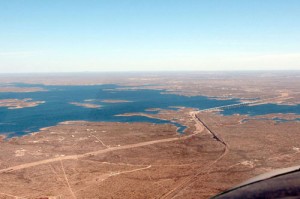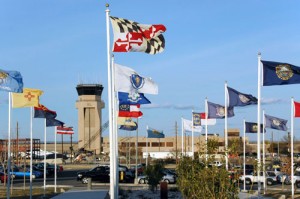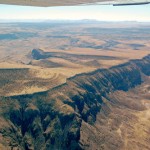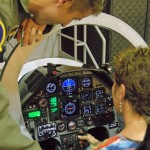By Greg Brown
“Let’s help Austin set up his new apartment,” said Jean. Only a dedicated mom thinks an Air Force officer needs help arranging his residence, especially on Super Bowl weekend. Then again, here was our chance to visit our son as he fulfilled his lifelong dream of becoming a military pilot.
Del Rio, Texas, is a long way from Phoenix, so I was delighted when tailwinds accelerated our progress that Friday morning. Our Flying Carpet normally cruises at 140 knots, but by the New Mexico border, we surfed along at 170. Half our solitary journey lay in Texas, and with few towns beyond El Paso, the Rio Grande proved our only companion. By the time Amistad Reservoir filled our windshield, we were doing 180 wonderful knots and almost hated to land. Just four hours from takeoff, we joined the traffic pattern over sleepy Del Rio, across the river from Ciudad Acuña, Mexico. It was an astounding performance for a straight-leg Cessna 182. Rarely do such powerful winds extend for 600 miles.
At Laughlin Air Force Base that evening, T-6 Texan II trainers circled the pattern. Austin took us for Mexican food, and we toured downtown Del Rio. Next morning Austin demonstrated the flight simulators on which he trains. After sampling Texas barbeque, we visited Amistad Reservoir and admired cliff paintings at Seminole State Park. Then Jean supervised tidying our son’s apartment. Under a rug, she discovered Austin’s practice traffic pattern outlined in masking tape.
“Good thing he keeps busy with training,” she chuckled privately, “or life might be pretty quiet here.”

With few towns beyond El Paso, the Rio Grande proves our only companion. Mexico lies on the other side.
Sunday over breakfast, I phoned for weather. Although clear skies prevailed, so did the same weather pattern we’d experienced on Friday, but with stronger westerly winds than ever.
“They’re talking moderate turbulence,” I lamented to Jean, “and 36-knot headwinds all the way home.”
We stayed low for the first 50 miles to dodge the brunt of the winds, but then climbed to clear terrain. Lower and lower sagged our groundspeed as we ratcheted skyward, until at 8,500 feet our Flying Carpet settled at a meager 90 knots.
“Surely this can’t last,” I grumbled, but it did. To pass time we munched snacks and photographed the severe landscape.
“Ugh,” moaned Jean after an eternity of bumping and bouncing. “Three hours aloft and we aren’t even to El Paso yet.”
Clearly, a fuel stop would be required. We were discussing options when the orange “low voltage” indicator lit up our panel.
“Now what?” said Jean, upset.
Here we languished over trackless badlands with a failed alternator circuit. There was no danger in it; under clear skies we could turn off the battery electrical system altogether and navigate via pilotage and our portable GPS. But the headwind had deprived us of adequate fuel to reach Phoenix. Help might be hard to find on Super Bowl Sunday, so wherever we landed we must be prepared to stay.
I briefed Albuquerque Center, explained that we’d temporarily leave the frequency, and changed our destination to El Paso, where we might find service.
“I’ll inform El Paso Approach,” said the controller. “If able, call me back in 12 minutes.”
I turned off the electrical system and began troubleshooting. Months earlier, we’d experienced a similar in-flight problem when the alternator regulator circuit breaker had popped. After resetting it, everything had returned to normal and stayed that way. At the time, our trusty mechanic could find nothing wrong with the charging system.
“I can’t fix this intermittent problem until it happens more consistently,” he’d explained. “Fortunately, it’s only the regulator circuit and shouldn’t harm anything else.”
Now, 20 flight hours later, the same circuit breaker had popped again. Jean retrieved the handheld GPS while I shut down the panel and waited 10 minutes for everything to cool down. Accepted practice is to reset circuit breakers only once when they pop; if it happens again something nasty is going on.
“Cross your fingers,” I said to Jean. Gingerly I reset the breaker and activated the master switch.
The errant breaker remained engaged, and the low voltage light stayed off. But what, if anything, might again trigger the breaker? Cringing, I flipped on the radio master, then one radio, and a few minutes later, the transponder. The radio sounded scratchy at first, but that proved to be another pilot’s handheld transceiver—hearing of our electrical problems, he was testing his backup.
“Why don’t we have a portable radio?” asked Jean.
“I’ve been meaning to get one,” I replied.
“Well Greg, you are hereby authorized to buy one.”
“Contact El Paso Approach,” advised Albuquerque, “and good luck.”
Even with the electrical system back online, our dilemma remained. Though our battery might continue charging in flight, any refueling stop would be a potential failure point. And if the problem recurred on the ground after startup, we couldn’t take off again. I radioed El Paso Unicom, only to learn there were no mechanics on duty.
Knowing we might be marooned wherever we landed, Jean and I decided to proceed closer to home. I informed El Paso Approach and onward we droned, still using only one radio, our transponder and the handheld GPS.
Deming, N.M. offered fuel when I radioed, but claimed no maintenance, even during the week. No good getting stranded there. Silver City also had fuel, but no maintenance. Our remaining option, Safford, Ariz., lay out of radio range. That, too, is a quiet place, so we dared not gamble further on fuel or repair services.
Remembering mechanics within driving distance of Silver City, we landed there in howling winds. All systems worked perfectly after refueling, so, delightedly, we steered homeward. Only in the final hour did our groundspeed crack 100 knots. Thirty minutes out, I tried to isolate the electrical problem by sequentially activating every possible cockpit switch. The breaker never popped. Six and a half flight hours after takeoff, we finally arrived in Phoenix—dazed, battered, and yet elated. We’d missed the Super Bowl, but scored our own winning home-field touchdown.
Author of numerous books and articles, Greg Brown is a columnist for AOPA Flight Training magazine. Read more of his tales in “Flying Carpet: The Soul of an Airplane,” available through your favorite bookstore, pilot shop, or online catalog, and visit [http://www.gregbrownflyingcarpet.com].
- Suffering 40-knot headwinds, we languish over trackless West Texas badlands with a failed alternator circuit.
- Sunset illuminates the 47th Flying Training Wing Headquarters, Laughlin AFB. Still, the wind keeps blowing.
- Austin briefs Jean on the T-6 Texan II procedures simulator.











